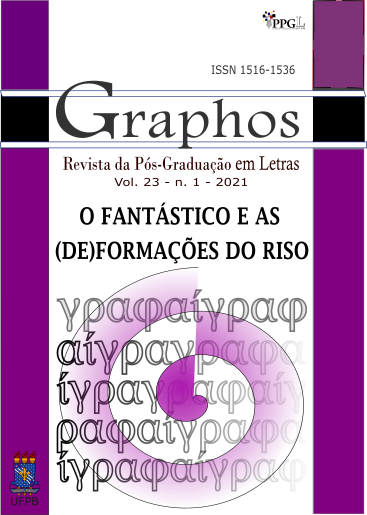The comic and the fantastic in “The Nose”, by Akutagawa
DOI:
https://doi.org/10.22478/ufpb.1516-1536.2021v23n1.57735Keywords:
Ryûnosuke Akutagawa (1892-1927), O Nariz, Fantastic, Humor, GroteAbstract
In this work, we analyze the short story “The nose”, by the Japanese writer Ryûnosuke Akutagawa (1892-1927), seeking to examine how comic and fantastic are combined in the narrative. Akutagawa is best known for the authorship of “Rashômon”, a short story that served as inspiration for the eponymous film by Akira Kurosawa (1910-1998) - although most of the film’s plot is based on the narrative titled “In a grove”, also by Akutagawa. The short story “The nose”, adapted from Konjaku Monogatari, a collection of folk tales from the Heian period (794-1185), was also influenced by the famous work of the same name by Nicolai Gógol (1809-1852), as noted by the Korean critic Beongcheon Yu (1976). For David Roas (2014), “The nose”, by Gógol, is an example of the grotesque, because, in this story, humor would nullify the fantastic effect. This is because, for the Spanish theorist, the fantastic is built from an event within the narrative that leads the reader to question his own conception of reality. So, for the fantastic effect to take place, a good deal of realism in the narrative is needed, evidently combined with something supernatural. But, in view of the completely absurd events reported in the story of Gógol, the characteristic anxiety of the fantastic would lose its strength, yielding to humor. This combination of the supernatural and humor is considered by Roas to be grotesque. It is worth investigating, therefore, if something similar also happens in Akutagawa's “The nose”.
Downloads
References
AKUTAGAWA, Ryûnosuke. Contos fantásticos. São Paulo: Editora Z, 2003.
ARÊAS, Vilma. Iniciação à comédia. Rio de Janeiro: Zahar, 1990.
ARISTÓTELES; HORÁCIO; LONGINO. A poética clássica. São Paulo: Cultrix, 1995.
BAKHTIN, Mikhail. A cultura popular na Idade Média e no Renascimento. São Paulo: Brasília: Hucitec, Edunb, 1993.
FURTADO, Filipe. “Fantástico (modo)”. E-dicionário de termos literários (EDTL), coord. de Carlos Ceia, ISBN: 989-20-088-9. Disponível em: http://www.edtl.com.pt. Acesso em: 22 abr. 2021.
GAMA-KHALIL, Marisa Martin. “A literatura fantástica: gênero ou modo?”. Terra roxa e outras terras: Revista de estudos literários. Londrina: UEL. Disponível em: http://www.uel.br/pos/letras/terraroxa/g_pdf/vol26/TR26b.pdf. Acesso em: 22 abr. 2021.
GÓGOL, Nicolai. O nariz. In: CALVINO, Italo (org.). Contos fantásticos do século XIX. São Paulo: Companhia das Letras, 2004.
KAUPATEZ, Digo. “Posfácio”. In: AKUTAGAWA, Ryûnosuke. Contos fantásticos. São Paulo: Editora Z, 2003.
KAYSER, Wolfgang. O grotesco: configuração na literatura e na pintura. São Paulo: Perspectiva, 1986.
LIPPIT, Noriko Mizuta. “From tale to short story: Akutagawa's Toshishun and It's Chinese Origins”. In: Reality and Fiction in Modern Japanese Literature. M. E. Sharpe Inc., 1980, pp. 39–54. Disponível em: https://www.enotes.com/topics/akutagawa-ryunosuke/critical-essays/criticism. Acesso em: 09 fev. 2021.
MAUPASSANT, Guy de. “O Horla”. In: MAUPASSANT, Guy de. O Horla e outras histórias. Porto Alegre: L&PM, 1986.
PIRANDELLO, Luigi. O humorismo. São Paulo: Experimento, 1996.
ROAS, David. A ameaça do fantástico: aproximações teóricas. São Paulo: Unesp, 2014.
TODOROV, Tzvetan. Introdução à literatura fantástica. São Paulo: Perspectiva, 2003.
WU, Fengjuan. “Research on personalities of characters in Ryûnosuke Akutagawa’s early works”. In: Proceedings of the 2017 International Conference on Culture, Education and Financial Development of Modern Society. Disponível em: https://www.atlantis-press.com/proceedings/iccese-17/25875316. Acesso em: 10 fev. 2021.
YU, Beongcheon. “The flight to Paranassus”. In: AKUTAGAWA: an introduction. Wayne State University Press, 1972, pp. 15-42. Disponível em: https://www.enotes.com/topics/akutagawa-ryunosuke/critical-essays/criticism. Acesso em: 09 fev. 2021.
Downloads
Published
Issue
Section
License
Copyright (c) 2021 Fábio Furuzato

This work is licensed under a Creative Commons Attribution 4.0 International License.







